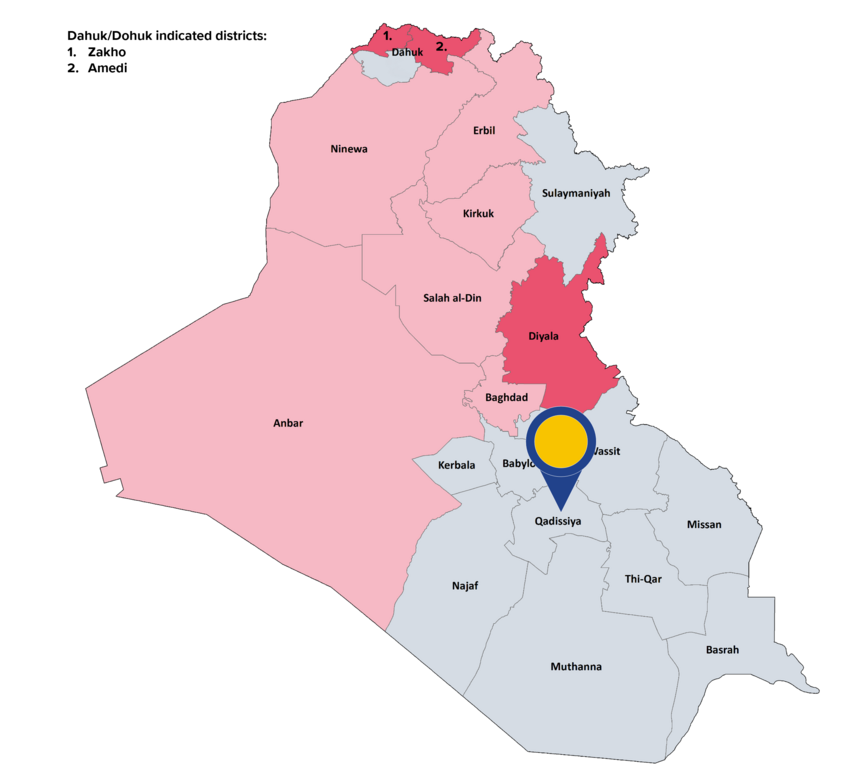COMMON ANALYSIS
Last update: June 2022
General information
Qadissiya governorate is located in southern-central Iraq and borders Babil, Wassit, Dhi Qar, Muthanna and Najaf governorates. The governorate is divided into the following districts: Diwaniya, Afak, Al-Shamiya and al Al-Hamza. The capital city of the governorate is Diwaniya. The Iraqi CSO estimated the governorate’s population for 2021 at1 394 885, with the majority being Shia Arabs.
The governorate’s economy is largely agricultural. It has been reported that Qadissiya had the largest number of locations affected by water shortage.
Background of the conflict
Assessments of the security situation from 2015 rated Qadissiya governorate as ‘relatively peaceful’ and southern Iraq overall as ‘more secure’, when comparing the area to other parts of the country. However, violence between Shia armed factions and tribal conflicts had been reported in the past. Between October 2019 and March 2021, demonstrations demanding reforms and economic and social rights took place in the governorate.
Actors: control and presence
Qadissiya governorate is under the control of ISF. As of December 2019, units of the ISF – the Middle Euphrates Operation Command (MEOC), a commando brigade, emergency regiments, local police and a brigade of the federal police – were active in Qadissiya governorate. On 8 January 2021, the withdrawal of Iraqi Army forces from Qadissiya was announced. Internal security control has already been handed over from the ministry of defence to the interior ministry in Qadissiya governorate.
Presence of PMF and other groups such as Ashab al-Kahf and Qasim Al-Jabarin was also reported.
Nature of violence and examples of incidents
Qadissiya governorate was affected by IED attacks on convoys supporting the International Coalition against ISIL. Security forces or contractors were sometimes injured or killed in these attacks and in some instances damage of vehicles was reported. Between 14 August 2020 and 9 September 2021, EPIC mentions 28 such attacks in the governorate and three attacks at unspecified locations on highways between Qadissiya and neighbouring governorates. Regarding some of the attacks targeting convoys between March and September 2021, Ashab Al-Kahf claimed responsibility. In 2019 and 2020, mass protests took place in Iraq’s southern governorates that were reportedly harshly suppressed by state security forces and paramilitary groups on numerous occasions.
In addition, clashes between tribal militias were also reported, and clashes between tribes sometimes occurred on grounds of minor disputes.
Incidents: data
In the reference period, ACLED reported a total of 36 security incidents (average of 0.6 security incidents per week) in Qadissiya of which 21 incidents were coded as explosions/remote violence, 9 as violence against civilians and 6 as battles. UNAMI[40] recorded no armed conflict-related incidents in the reference period.
Geographical scope
While all Qadissya’s districts were affected by security incidents, the majority of them was recorded in Diwnaiya district.
Civilian casualties: data
UNAMI recorded no casualties in the reference period.
Displacement
As of 30 September 2021, Qadissiya had 3 516 IDPs. No IDPs originating from Qadissiya were registered in other part of the country. Qadissiya was not listed among the governorates with a presence of returnees.
Further impact on civilians
Qadissiya is reportedly contaminated with cluster munition remnants and with ERW. As of August 2020, the area contaminated with ERW in the governorate was listed as 57 665 073 square metres. As of the end of the year 2020, the area contaminated by cluster munition remnants was 3 137 824 square meters.
|
|
Looking at the indicators, it can be concluded that in the governorate of Qadissiya there is, in general, no real risk for a civilian to be personally affected within the meaning of Article 15(c) QD. |
Main COI references: Security 2022, 2.16

[40] UNAMI data focuses on armed conflict-related incidents, which have directly impacted civilians (causing civilian casualties) and the civilian nature of property and protected areas (such as civilian houses, cropland, schools, health facilities and mosque), see ‘Indicators of indiscriminate violence, number of incidents’.
